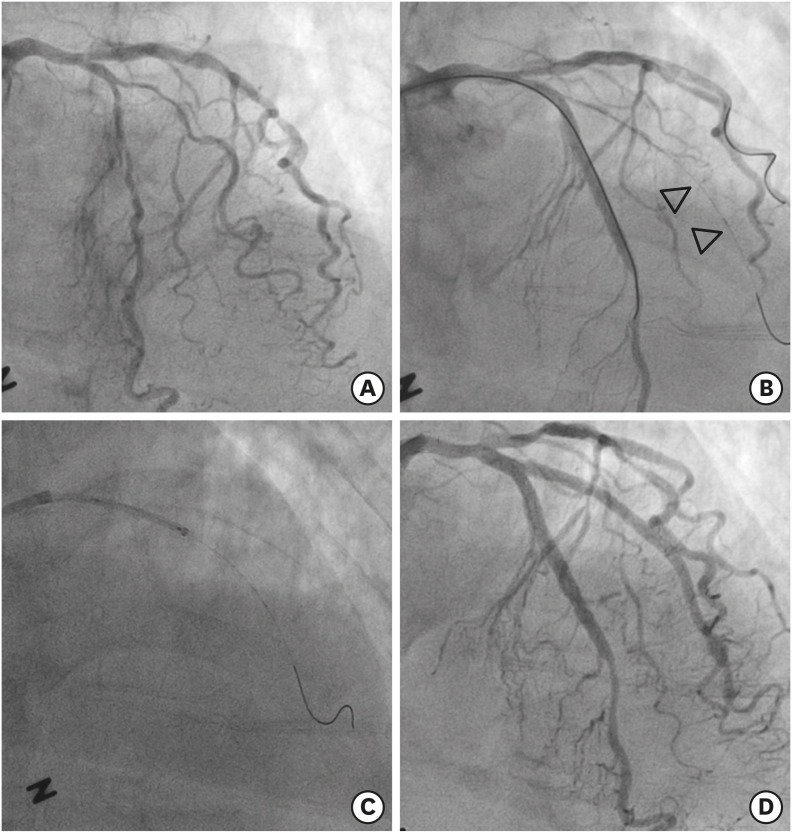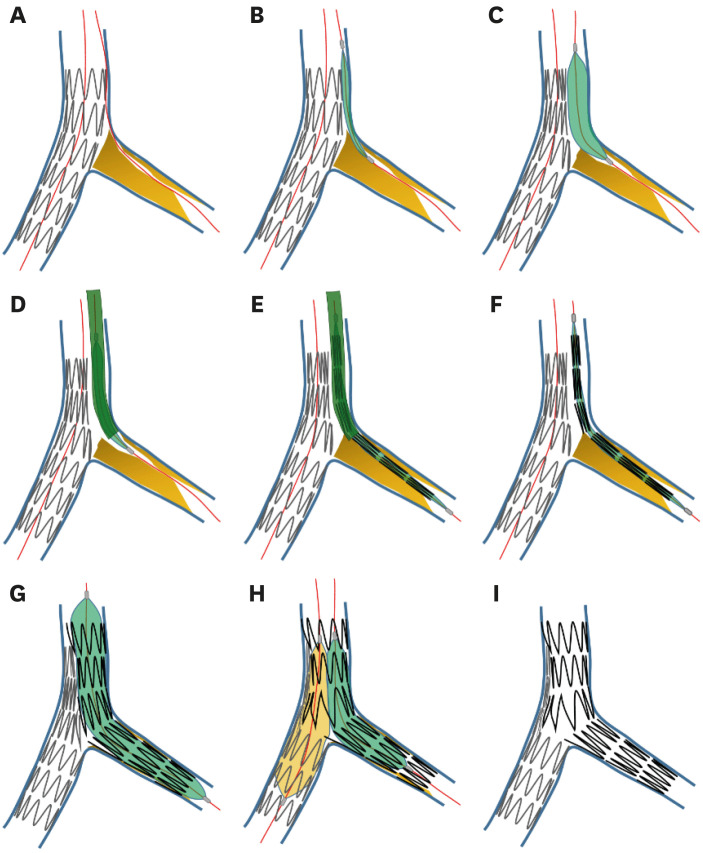An 83-year-old female showed bifurcation disease at the proximal left anterior descending (LAD) artery (Figure 1A, Supplementary Videos 1 and 2). The patient complained of chest pain after the LAD stenting (Orsiro® stent 2.5×40 mm; Biotronik, Berlin, Germany), and angiography demonstrated compromised diagonal side branch (SB) (Supplementary Video 3). Even though we tried to pass the SB, we made a huge dissection propagating into the distal SB (Figure 1B, Supplementary Video 4). The systolic blood pressure decreased to 64 mmHg.
We performed the ‘rescue’ balloon jailing and a switch crush technique to open the jailed SB (Figure 2). First, we dilated the compromised SB ostium over the jailed SB wire with 1.5-mm and 2.5-mm balloons sequentially (Figure 2A-C). Externally, we introduced a second stent long enough to cover from the proximal part to the LAD stent and beyond the dissection flap into the jailed SB (two Orsiro® stents 2.5×35 and 2.75×40 mm; Biotronik), facilitated by the guide extension catheter minimizing friction with the pre-implanted LAD stent (Figure 1C and Figure 2D-F, Supplementary Videos 5 and 6). Following SB stent implantation (Figure 2G), we rewired the LAD lesion through the LAD stent struts and performed a final kissing balloon inflation (two NC Emerge™ balloons, 3.0×15 and 2.75×15 mm; Boston Scientific Corporation [BSC], Natick, MA, USA) (Figure 2H, Supplementary Videos 7 and 8).
Even after applying the ‘rescue’ balloon jailing technique,1)2) we could not rewire the SB due to severe SB dissection. Under such emergency, the novel ‘switch crush technique’ represents the last option to save the significant SB in danger.
We obtained informed consent from the patient and her son to report the case.
Notes
Funding: The authors received no financial support for the research, authorship, and/or publication of this article.
References
1. Aminian A, Dolatabadi D, Lalmand J. Small balloon inflation over a jailed wire as a bailout technique in a case of abrupt side branch occlusion during provisional stenting. J Invasive Cardiol. 2010; 22:449–452. PMID: 20814055.
2. Burzotta F, Trani C. Jailed balloon protection and rescue balloon jailing techniques set the field for safer bifurcation provisional stenting. Int J Cardiol. 2015; 201:376–377. PMID: 26310980.

Figure 1
Coronary angiographic findings. Severe stenosis involving bifurcation of the left anterior descending coronary artery (A). During the dissection spreads to the distal SB, blood flow was blocked (arrowhead; B). The guide extension catheter is inserted into the SB (C) and the final angiography (D).
SB = side branch.

Figure 2
A schematic representation of the ‘rescue’ balloon jailing and switch crush technique. Compromised SB (A). ‘Rescue’ balloon jailing technique with a small balloon (B). Inflation of the jailed SB with a larger balloon (C). Delivery of the guide extension catheter (D). The SB stent is inserted through the guide extension catheter (E, F). SB stent expansion (G). The final kissing balloon inflation (H) and the final result (I).
SB = side branch.





 PDF
PDF Citation
Citation Print
Print




 XML Download
XML Download